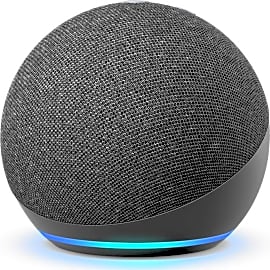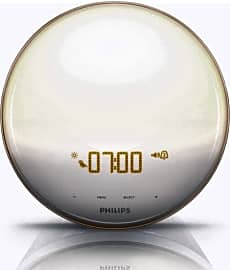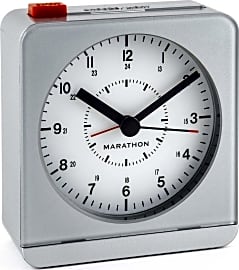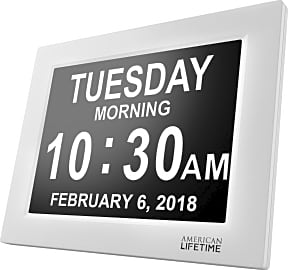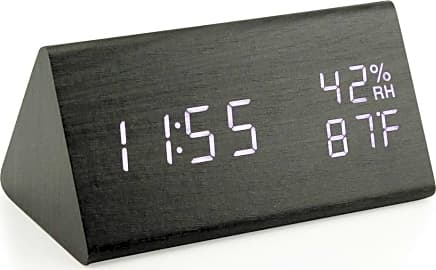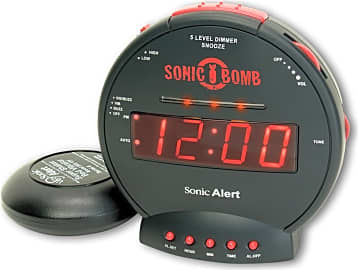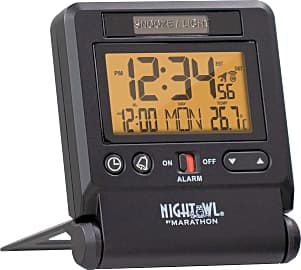The 10 Best Alarm Clocks

This wiki has been updated 38 times since it was first published in May of 2015. An alarm clock can be your most hated enemy, especially at 5 a.m. when it is robbing you of precious sleep and reminding you that you have to work for a living. But they are, for most, a necessary evil, so we have curated a selection that provide easy-to-read displays, loud ringers, and, very importantly, prominent snooze buttons. Some even double as Bluetooth speakers. When users buy our independently chosen editorial recommendations, we may earn commissions to help fund the Wiki.
Editor's Notes
December 28, 2020:
Without a doubt, the most functional alarm clock on our list is the Amazon Echo Dot. As with all of the company's connected devices, it allows for voice control via Alexa and can perform all the tasks you expect of her, including providing you with the day's weather forecast, acting as an intercom between rooms, and working as a speakers for playing music via Bluetooth or streaming services. The Brandstand CubieBlue also doubles as a Bluetooth speaker, and we think many users will appreciate its array of ports and outlets for charging all their other devices. Even its power plug has a passthrough socket, so it technically doesn't even use up one of your outlets. When it comes to simplicity, both in design and use, the Peakeep Twin Bell immediately stands out, while the Oct17 Wooden is notable for its simple design, though conversely, a complicated operation. Those looking to wake up in the most natural way possible should turn to the Philips SmartSleep HF3520, which is a wake-up light that simulates the sunrise, and heavy sleepers will want to choose the Sonic Alert Bomb.
December 03, 2019:
Our list is pretty digital-heavy, so in today’s update we wanted to add in another old-school analog model for those who prefer the simple, straightforward layout they grew up with. The Peakeep Twin Bell fits the bill, as it’s got a classic sounding alarm (as its name implies) and runs on just a single AA battery. Unlike many traditional models, however, this one does not tick, so light sleepers (and anyone else likely to be driven crazy by such a sound) need not worry. It features prominent hands and numbers that contrast nicely against its solid-colored face. It's available in an array of attractive colors that include black, white, green, red, and pink. Leaving the list to make room for this new addition is the Homtime Multi-Function, an easy-to-use model but one that’s hard to read from angles other than straight on.
Also joining the list today is the Philips Wake-Up Light, which is great for those who prefer to wake up gradually without the jarring sound of beeping, ringing, or a radio. It’s a lamp that mimics sunlight, and emits light with gradually increasing intensity to wake you up. You can also choose to have it accompanied by soothing birdsong, piano music, lapping waves, and more.
Also featured here is the Sonic Alert Bomb, which is designed with the heaviest of sleepers in mind, as well as anyone who is hearing impaired. It’s equipped with an impressive 113-decibel buzzer as well as a shaker device that can be placed under your pillow or mattress as another means of ensuring you’re up on time. For other choices that are similar to this one, check out or list of the best alarm clocks for heavy sleepers.
If you’re in the market for an alarm clock that’s geared specifically toward children (aging in range from tiny tots through teenagers), check out our list of the best kids’ alarm clocks.
Special Honors
Wideboy Alarm Clock This retro timepiece was designed by a husband and wife duo of artists and is sold by the Museum of Modern Art. It’s inspired by classic British clock designs from the 19th and 20th centuries and features a rectangular casing and a matte black finish, with a digital beep alarm. Equipped with an atomic dial and silently sweeping movement, it won’t disturb light sleepers or those sensitive to certain sounds. moma.org
Bagby Couples Phone Detox Kit This product is actually a lot more than just an alarm clock, since it's part of a larger kit that includes two identical ones. It’s been invented by entrepreneurs as a way for distracted couples to spend more quality time together by choosing to become smartphone-free at night. It comes with two bags to tuck your phones into at bedtime (and yes, they feature slots for charging), as well as the two small analog alarm clocks that are made of solid pine wood, to ensure you won’t need to be woken up by your phone’s alarm. Also included are sets of postcards so each partner can spend their newly acquired time writing love notes to the other or simply listing out the things they appreciate. bagby.co
How To Avoid The 5 Most Common Alarm Clock Fails
The only two ways of getting around this are by confirming which alarm you've set, or by replacing the clock you're using with a model that only offers one alarm.
Alarms are a necessary sound, but they are rarely a welcome one. The very word "alarm" connotes a sense of fear or urgency. In the case of an alarm clock, however, that sense of urgency means that the mechanism is working, and that it has either woken you up or provided you with a reminder to get something done.
This explains why it seems so frustrating to be woken up by an alarm that has been going off for several minutes, or worse yet, to wake up late due to an alarm that never actually went off at all. In that spirit, here is a list of the top 5 alarm clock fails, along with some ideas about how to avoid each one:
1) AM/PM: In the age of digital clocks, this is the most common reason that an alarm will fail to go off. Even if you are exhausted, it is critical to confirm whether you have set an alarm for AM or PM hours, especially when you are in an unfamiliar place, and you are dealing with an unfamiliar alarm.
2) You've Changed The Time: We've all been there - one slip of the finger, and you've jumped ahead anywhere from several minutes to several hours. The best way to avoid this is by checking the time on the clock after you have set the alarm, and then readjusting the time, if it happens to be wrong.
3) The Volume's Turned Down: This is germane to cellphones and clock radios. In both cases, it pays to check the volume on your device after you have set the alarm.
4) The Batteries Are Dead: If you still happen to be using a battery-operated alarm, be sure to check or replace the batteries regularly, especially if you notice the clock beginning to stall.
5) Alarm 1/Alarm 2: Clocks that offer the option of setting two separate alarms aren't necessarily doing you a favor. There's always a chance you'll set the clock to the wrong alarm. The only two ways of getting around this are by confirming which alarm you've set, or by replacing the clock you're using with a model that only offers one alarm.
How Do I Choose A Decent Alarm Clock?
It's a challenge to know whether you're buying a worthwhile alarm clock based on little more than a photo, or a handful of models that are lined up on a shelf. You may want to go a step further to ensure that you're buying the right one.
You may want to go a step further to ensure that you're buying the right one.
First things first, you want to purchase an alarm which features numbers that are bright (but not too bright). This is important not only for when you're waking up, but also for when you just want to see what time it is during the middle of the night.
Next, you want an alarm that you can hear. And while this sounds like a no-brainer, keep in mind that you may have white noise - like a fan, or an air conditioner, or a television - competing for your ear. If you find the phrase adjustable volume in an alarm clock's description, followed by terms like loud or explosive, you're probably in the right place.
Finally, see if you can find any videos of the model that you're interested in online. Videos by consumer advocates are bound to provide some indication of how loud or penetrating an alarm is, while also showing off some of the ancillary features that an alarm clock has to offer.
A Brief History Of The Alarm Clock
Whether you're talking about the 30-second collage of alarm clocks at the beginning of Pink Floyd's "Time," or those old Dunkin' Donuts commercials, one of which began with a wind-up alarm going off before Fred the Baker said, "Time to make the donuts," almost everyone can point to some connection between the modern alarm clock and popular culture.
During the early 20th Century, advances allowed for alarm clocks to be produced on a mass level.
What most people don't realize is that the alarm clock has been around for ages. The philosopher Plato was said to have constructed an archaic alarm for his water clock way back in Ancient Greece. The Ancient Romans constructed "alarm gongs" for the giant clocks that were placed in their public squares. Next came the Chinese, and then the Buddhists. By the 15th Century, alarm clocks were spreading across Europe, where church towers featured ornamental clocks that were hooked up to chimes or bells that would echo throughout the region.
During the early 20th Century, advances allowed for alarm clocks to be produced on a mass level. By the 1930s wind-up clocks - and even early electric clocks - had become a fixture in the American home. Radio alarm clocks became huge during the seventies, and they remained the industry standard for another 25 years.
Today most people rely upon their cell phones for everyday alarms. Despite this the alarm clock industry continues to advance. New technology has allowed for everything from ascending-sound alarms (i.e., an alarm that increases in volume to keep from jarring someone who is in a deep sleep) to radiant-light alarms (i.e., a light that increases in brightness until the person is awake). As long as people have a need to wake up at a certain time every day, it's safe to assume that the alarm clock in some form isn't ever going away.



